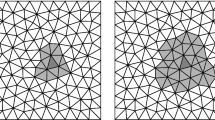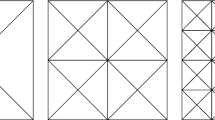Abstract
Generalizing the framework of an ultra-weak formulation for a hypersingular integral equation on closed polygons in Heuer and Pinochet (SIAM J Numer Anal: 52(6), 2703–2721, 2014), we study the case of a hypersingular integral equation on open and closed polyhedral surfaces. We develop a general ultra-weak setting in fractional-order Sobolev spaces and prove its well-posedness and equivalence with the traditional formulation. Based on the ultra-weak formulation, we establish a discontinuous Petrov–Galerkin method with optimal test functions and prove its quasi-optimal convergence in related Sobolev norms. For closed surfaces, this general result implies quasi-optimal convergence in the \(L^2\)-norm. Some numerical experiments confirm expected convergence rates.






Similar content being viewed by others
Notes
References
Ainsworth, M., McLean, W., Tran, T.: The conditioning of boundary element equations on locally refined meshes and preconditioning by diagonal scaling. SIAM J. Numer. Anal. 36, 1901–1932 (1999)
Bebendorf, M.: Approximation of boundary element matrices. Numer. Math. 86(4), 565–589 (2000)
Bergh, J., Löfström, J.: Interpolation Spaces. Number 223 in Grundlehren der mathematischen Wissenschaften. Springer-Verlag, Berlin (1976)
Bottasso, C.L., Micheletti, S., Sacco, R.: The discontinuous Petrov-Galerkin method for elliptic problems. Comput. Methods Appl. Mech. Eng. 191(31), 3391–3409 (2002)
Bramwell, J., Demkowicz, L., Gopalakrishnan, J., Qiu, W.: A locking-free \(hp\) DPG method for linear elasticity with symmetric stresses. Numer. Math. 122(4), 671–707 (2012)
Brezzi, F., Fortin, M.: Mixed and hybrid finite element methods. Springer series in computational mathematics, vol. 15. Springer-Verlag, New York (1991)
Broersen, D., Stevenson, R.: A Petrov-Galerkin discretization with optimal test space of a mild-weak formulation of convection-diffusion equations in mixed form. IMA J. Numer. Anal. 35(1), 39–73 (2015)
Buffa, A., Costabel, M., Sheen, D.: On traces for H(curl, \(\Omega \)) in Lipschitz domains. J. Math. Anal. Appl. 276, 845–867 (2002)
Buffa, A., Sauter, S.: On the acoustic single layer potential: stabilization and Fourier analysis. SIAM J. Sci. Comput. 28(5):1974–1999 (electronic) (2006)
Cessenat, O., Després, B.: Application of an ultra weak variational formulation of elliptic PDEs to the two-dimensional Helmholtz problem. SIAM J. Numer. Anal. 35(1), 255–299 (1998)
Chan, J., Heuer, N., Bui-Thanh, T., Demkowicz, L.: Robust DPG method for convection-dominated diffusion problems II: Adjoint boundary conditions and mesh-dependent test norms. Comput. Math. Appl. 67(4), 771–795 (2014)
Chandler-Wilde, S.N., Graham, I.G.: Boundary integral methods in high frequency scattering. In: Highly oscillatory problems, volume 366 of London Math. Soc. Lecture Note Ser., pp. 154–193. Cambridge Univ. Press, Cambridge (2009)
Chandler-Wilde, S.N., Graham, I.G., Langdon, S., Spence, E.A.: Numerical-asymptotic boundary integral methods in high-frequency acoustic scattering. Acta Numer. 21, 89–305 (2012)
Costabel, M.: Boundary integral operators on Lipschitz domains: Elementary results. SIAM J. Math. Anal. 19, 613–626 (1988)
Demkowicz, L., Gopalakrishnan, J.: Analysis of the DPG method for the Poisson problem. SIAM J. Numer. Anal. 49(5), 1788–1809 (2011)
Demkowicz, L., Gopalakrishnan, J.: A class of discontinuous Petrov-Galerkin methods. Part II. Optimal test functions. Numer. Methods Partial Differ. Equ. 27, 70–105 (2011)
Demkowicz, L., Gopalakrishnan, J., Muga, I., Zitelli, J.: Wavenumber explicit analysis of a DPG method for the multidimensional Helmholtz equation. Comput. Methods Appl. Mech. Eng. 213–216, 126–138 (2012)
Demkowicz, L., Heuer, N.: Robust DPG method for convection-dominated diffusion problems. SIAM J. Numer. Anal. 51(5), 2514–2537 (2013)
Després. B.: Sur une formulation variationnelle de type ultra-faible. C. R. Acad. Sci. Paris Sér. I Math. 318(10), 939–944 (1994)
Engleder, S., Steinbach, O.: Stabilized boundary element methods for exterior Helmholtz problems. Numer. Math. 110(2), 145–160 (2008)
Ervin, V.J., Heuer, N.: An adaptive boundary element method for the exterior Stokes problem in three dimensions. IMA J. Numer. Anal. 26(2), 297–325 (2006)
Gatica, G.N., Healey, M., Heuer, N.: The boundary element method with Lagrangian multipliers. Numer. Methods Partial Differ. Equ. 25(6), 1303–1319 (2009)
Girault, V., Raviart, P.-A.: Finite element methods for Navier–Stokes equations, volume 5 of Springer series in computational mathematics. Theory and algorithms. Springer-Verlag, Berlin (1986)
Gopalakrishnan, J., Qiu, W.: An analysis of the practical DPG method. Math. Comp. 83(286), 537–552 (2014)
Grisvard, P.: Elliptic problems in nonsmooth domains. Pitman Publishing Inc., Boston (1985)
Hackbusch, W.: A sparse matrix arithmetic based on \(H\)-matrices. I. Introduction to \(H\)-matrices. Computing 62(2), 89–108 (1999)
Hackbusch, W.: Hierarchische Matrizen: Algorithmen und Analysis. Springer, New York (2009)
Heuer, N.: Additive Schwarz method for the \(p\)-version of the boundary element method for the single layer potential operator on a plane screen. Numer. Math. 88(3), 485–511 (2001)
Heuer, N.: On the equivalence of fractional-order Sobolev semi-norms. J. Math. Anal. Appl. 417(2), 505–518 (2014)
Heuer, N., Karkulik, M.: A robust DPG method for singularly perturbed reaction-diffusion problems. (2015). arXiv:1509.07560
Heuer, N., Karkulik, M., Sayas, F.-J.: Note on discontinuous trace approximation in the practical DPG method. Comput. Math. Appl. 68, 1562–1568 (2014)
Heuer, N., Pinochet, F.: Ultra-weak formulation of a hypersingular integral equation on polygons and DPG method with optimal test functions. SIAM J. Numer. Anal. 52(6), 2703–2721 (2014)
Hsiao, G.C., Wendland, W.L.: Boundary integral equations. Springer, New York (2008)
Maischak, M.: The analytical computation of the Galerkin elements for the Laplace, Lamé and Helmholtz equation in \(3\)D-BEM. Technical Report 95-16, DFG-Schwerpunkt Randelementmethoden (1995)
McLean, W.: Strongly elliptic systems and boundary integral equations. Cambridge University Press, Cambridge (2000)
Nédélec, J.-C.: Integral equations with nonintegrable kernels. Integral Equ. Oper. Theory 5, 562–572 (1982)
Roberts, R.E., Thomas, J.M.: Mixed and hybrid methods. In Ciarlet, P.G., Lions J.L. (eds.) Handbook of numerical analysis. Vol. II, pp. 523–639, North-Holland, Amsterdam (1991)
Steinbach, O.: A robust boundary element method for nearly incompressible linear elasticity. Numer. Math. 95(3), 553–562 (2003)
Stephan, E.P.: Boundary integral equations for screen problems in \({\mathbb{R}}^3\). Integral Equ. Oper. Theory 10, 257–263 (1987)
Zitelli, J., Muga, I., Demkowicz, L., Gopalakrishnan, J., Pardo, D., Calo, V.M.: A class of discontinuous Petrov-Galerkin methods. Part IV: the optimal test norm and time-harmonic wave propagation in 1D. J. Comput. Phys. 230(7), 2406–2432 (2011)
Author information
Authors and Affiliations
Corresponding author
Additional information
Supported by CONICYT through FONDECYT projects 1150056, 3140614 and Anillo ACT1118 (ANANUM).
Rights and permissions
About this article
Cite this article
Heuer, N., Karkulik, M. Discontinuous Petrov–Galerkin boundary elements. Numer. Math. 135, 1011–1043 (2017). https://doi.org/10.1007/s00211-016-0824-z
Received:
Revised:
Published:
Issue Date:
DOI: https://doi.org/10.1007/s00211-016-0824-z




